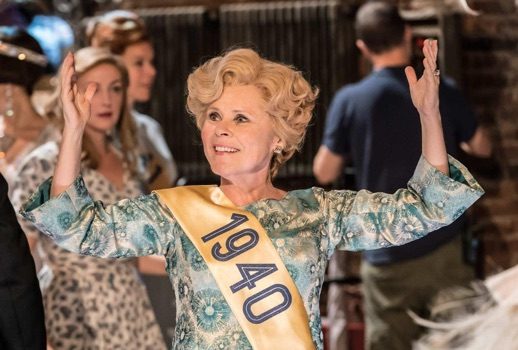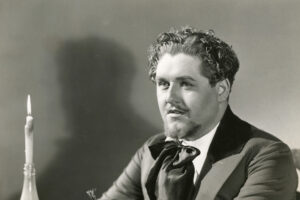

“Ta-da!”
I’ve always believed that Follies, like life, should be relentless and inescapable, so I jumped at the chance to see Dominic Cooke’s new staging for the National, which is done without an intermission in keeping with the authors’ original intention.
Follies is structured as a long-form party from hell, going from the nervous energy of the first cocktail through drunken exuberance into a blistering hangover, and it works perfectly without a break. I’ll have trouble seeing any staging that does have an intermission now. (Note: this is hyperbole; I would see Follies done in a church basement with seven intermissions and any two of your aunts as Sally and Phyllis. Just email me the date.)
Several recent productions have shown the difficulties inherent in doing Follies (which is after all a show about putting on an elaborate show of who you are) on a budget. This production is delightfully lavish in its production values. The costumes, ranging from crazy showgirl headdresses for the ghosts to pitch-perfect recreations of period cocktail attire for the female cast, suitable for Merv Griffin’s guest chair, are exquisite. The production design, both the atmospheric theatrical ruins and the startling and suitably overwhelming “Loveland” sets, delivers.
The main piece of the set is a very active turntable that spins us nicely through the various episodes and numbers of the book. It’s dominated by a neon sign advertising the Follies and proclaiming that Mr. Weissman’s show is in the business of “Glorifying the American Girl.” This seemed like the perfect summation of the way society saw the generation of women the show is about: beautiful girls who, if they’re lucky, land husbands, and after the wedding, who cares how much they drink or cry or stand in the middle of the floor, not going left, not going right.
I’ll get right to it: Imelda Staunton is a controversial figure among American voice queens and I understand why; she’s a musical theater star who’s not even principally a singer, and “the instrument,” as I’m sure she has never referred to it, is nothing to phone your mum about.
With that said, I’m a full-on crazy Staunton stan. I worship the psychological specificity of her choices, the surprising emotional line readings, the pauses. I’m here for it all. If you’re ever at my apartment and enough wine is involved, there’s a non-zero chance I’ll find some way to guide the conversation to Into the Woods just so I can play you the live bootleg of “Moments in the Woods” where she tears through “Is it always ‘or’ / is it never ‘and’” with the ferocity of five millennia of silenced fairy tale wives and girlfriends.
As much as I adore her, I have to admit that I greeted this cast announcement with some serious skepticism, that secondhand fear you get when you feel your favorite diva ramping up to an optional e-flat she may have once sung gloriously in the shower when she was in college. Imelda had done “Broadway Baby” in a Follies concert once, and I could see her as Hattie, or as a particularly determined-to-be-still-here Carlotta or, at a stretch, a very dark Phyllis. But Sally? The, uh, part with all the, um, singing? Um.
I foresaw a lot of yelling to compensate for difficulty with the score, so when she raced on at the top of the show like Doris Day, sunny, with an aggressively buoyant Midwestern energy, I was shocked. This Sally is so happy to be at this sad reunion of middle-aged showgirls that you can’t help but be embarrassed for her—is life in Arizona really that boring?
But as she continues through “Don’t Look At Me” (frantic, with an edge of genuine fear), “In Buddy’s Eyes” (“Life is ducky” sounds like something this woman would actually say for once), and “Who’s That Woman” (tapping and grinning through Sally’s old chorus part, eyes relentlessly forward), I realized that something much scarier was happening. Staunton’s Sally starts in the full upswing of a manic phase and you sense that the crash is going to be terrifying.

So yes, you miss some soaring notes in her performance, especially in that duet, but for me, the compromise was well worth it. By “Losing My Mind,” she’s at the bottom of her downswing, flat and broken at a dressing table. I felt the fear in the lyrics this time, that whoever Sally was isn’t coming back from the reunion, not in any real sense. Her performance of the song is gently unsettling and creepy, like waking up from a dream and not being able to remember exactly who you are, rather than overtly heartbreaking, and needless to say I was there for it in a big way.
The other standout number was “I’m Still Here,” that delicious parade of ancient references that has flummoxed many a senior diva. There are your Too Tough To Die Carlottas (Polly Bergen, Karen Morrow, Dolores Gray); your Droll and Ironic Carlottas (Christine Baranski, Carol Burnett); your Who Cares What Show It Is, Annie’s Still Got It Carlottas (Ann Miller); your Say Something Nice Um I Guess Her Basic Voice Is Still Pretty Good Carlottas (Elaine Paige); and of course your Darling, You’re Fabulous, Can’t You Just Write The Lyrics On Your Hand Or Something Carlottas (Yvonne de Carlo), but I’m ready to cite Tracie Bennett as the first Carlotta who makes all the parts of the character work.
She’s larger-than-life and outrageous; she’s sexy; she’s a mess; she’s incredibly charismatic; she’s a survivor; and you absolutely believe that she would have an adoring crowd of younger people at her feet—as the staging calls for here—whenever she recounts her life story.
The director has Bennett sing the first half of the song to this group (cute touch: a gay man who is incredulous at the mention of “platinum hair”), then we flip into internal monologue as she steps away into a follow spot for the second half of the song. (It should be noted that Matthew Warchus similarly broke up the song at this point to lesser effect in his 2001 Broadway revival featuring too-tough-to-die-but-nevertheless-RIP Carlotta Bergen).
It’s clear here that this Carlotta is a star who keeps being a star because what the hell else could she possibly do, work retail? By the end of the song, Bennett has thrown her entire campy, magnificent being into it, vigorously applauding herself and literally screaming “I’m still here!” into the empty auditorium in a growl that suggests a breakfast diet of cigarettes and vodka. It’s a fantastic performance.
Janie Dee, the Phyllis, is, like many of the cast, well, to call her “not principally a singer” seems unkind and overly reductive, but let’s say I’m not going to be first in line the day she does a recital of Handel rarities. But this is almost always the case with the role, and she delivers the character’s arch wit, self-loathing, and outward-facing loathing extremely well. She suffers slightly by comparison to Staunton, who plumbs greater depths from Sally, but Phyllis, much as we all love and emulate her, is perhaps harder to find surprising layers in.
So here’s the sorrowful précis. At the performance I saw she spoke/growled/chested almost half of “Could I Leave You,” which was a bit too much for me, but it was a live-wire performance and very effective dramatically. She had a greater success in “The Story of Lucy and Jessie,” delightfully staged with her fully Rita Hayworthing atop an upright piano surrounded by boys and the Young Phyllis double.
Philip Quast—debonair and a lovely singer—was ideal as Ben, the kind of man you believe could fake his way to the top based on how well he wears a suit. The staging of his breakdown during his Follies number was handled in a genuinely unsettling and original way that’s worth seeing for yourself. Peter Forbes nailed both of Buddy’s solo numbers. “The Right Girl,” especially, benefits from being part of the continuous action instead of the world’s most underwhelming entr’acte.

“One More Kiss” is the ultimate distillation of Follies, to me and to many opera queens, I suspect; the past and present fighting for control of the song, the haunting repetition of “Never look back.” It’s staged simply here but it works.
As for the rest, the Whitmans and Solange handled their numbers excellently, the latter with the benefit of two chorus boys in berets. I was surprised by the take on “Broadway Baby,” which was presented introspectively, as if Hattie (Di Botcher) was tentatively recalling a strange, long-forgotten time when the only thing she cared about was being cast in Broadway shows. It was a valid interpretation, even if my taste is more for the Maxene Andrews/Mimi Hines/Ethel Shutta style of indefatigable ancient greasepaint addict.
The other showstopper, “Who’s That Woman?,” was well-staged, with the turntable constantly rotating so we could simultaneously enjoy both the showgirls and the aged hoofers, led by Stella (Dawn Hope). The transition to Loveland was suitably funny and uncomfortable, with the main quartet awkwardly onstage as various choristers in elaborate hats extoled the virtues of love. “You’re Gonna Love Tomorrow / Love Will See Us Through” got many genuine laughs throughout.
A smart directorial invention is the addition of a documentary crew to the early party scenes, to whom the old-timers speak much of their party dialogue. I loved this; it solves the book’s inherent awkwardness of having the audience “discover” guest after guest at the exact moment he or she is delivering a one-liner or brusque summation of their entire life story. It makes sense that these people would speak this way to a camera, for posterity.
The gaudily outfitted showgirls glide in and out for most of the show as we spin around the party, to haunting effect. A great early moment: the Follies ladies shuffle in and the ghosts swirl around them, each looking for herself. I focused on Young Hattie, a gorgeous Louise Brooks type, staring at middle-aged Hattie with confusion, revulsion, pity—that’s me? What the hell happened? Imagine your 22-year-old self watching you at a party now and cringe accordingly.
Follies done right is a tough show to enjoy. The escape from Loveland is dark for Sally and Buddy, and when they had left to take their Uber to a life whose only hope is death and Ben and Phyllis were left alone onstage, I felt my heart sink. But Phyllis’s last lines—about how making hope is the hardest and the most important thing people can do—hit me in a big way in this production, especially in these times when everything seems so grim. I needed to hear it.
All in all, I thought this production made the best possible case for Follies as a sustained, brilliant piece of musical theater, not a cultish mess one endures for favorite numbers. It was big and beautiful and unsettling and relentless and I need to get to London again before it closes so I can see it all one more time.
Photos: Johan Persson


























Comments